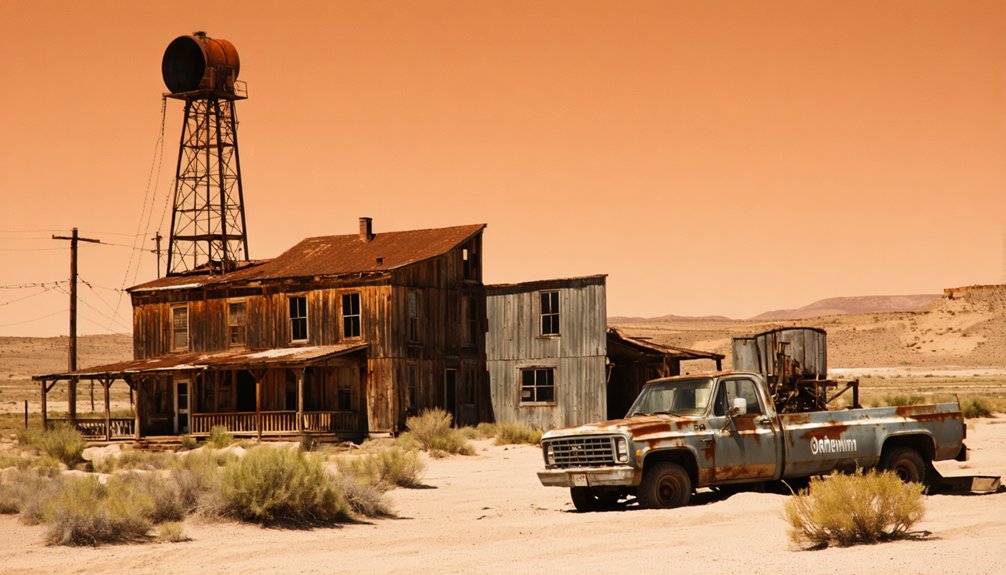Always secure legal permission before exploring abandoned oil ghost towns, as most are privately owned and trespassing can result in charges. Pack essential safety gear including sturdy boots, gloves, and a thorough first aid kit to protect against structural hazards. Document your discoveries with cameras and GPS while leaving artifacts undisturbed, preserving these historical treasures for future generations. The rusty relics of America’s petroleum past await your respectful footsteps.
Key Takeaways
- Obtain proper permission from property owners before visiting to avoid trespassing charges and legal issues.
- Bring essential safety gear including sturdy boots, gloves, and eye protection when exploring potentially hazardous structures.
- Research the site’s history and layout using historical maps to understand its significance and navigate effectively.
- Document findings with cameras and GPS while leaving artifacts undisturbed to preserve historical integrity.
- Inform someone of your exploration plans and bring emergency supplies for remote location safety.
Legal Research and Access Permissions
While the weathered buildings and rusting equipment of abandoned oil ghost towns beckon with nostalgic allure, your first adventure must begin not with footsteps on creaking floorboards, but with careful research into property records.
Despite their abandoned appearance, most oil ghost towns remain under private property ownership with legal rights fully intact.
The ghost in ghost town doesn’t signify legal abandonment—most remain privately owned with enforceable property rights.
Start by checking county assessor websites and land registries to identify current owners. Don’t assume a lack of “No Trespassing” signs grants access freedom—it doesn’t. Unauthorized entry could result in misdemeanor trespassing charges that carry penalties including fines and possible jail time.
Instead, reach out directly to property owners with a specific visitation request, securing written permission whenever possible. Many owners appreciate your interest in preserving history and will accommodate respectful explorers.
For historically designated sites, look into scheduled tours or managed access programs that offer legal pathways to discovery without risking trespassing charges.
Consider using historical maps available from state geological surveys to better understand the original layout of these abandoned places before visiting.
Essential Safety Equipment and Precautions
Although abandoned oil ghost towns promise adventure and historical discovery, your survival depends on meticulous preparation and proper equipment. Confirm your vehicle is mechanically sound with necessary recovery gear, including winches and tow straps. Never venture out with warning lights active or without a functional spare tire.
Your safety gear should include sturdy boots, gloves, and protective clothing to shield against sharp debris and unstable surfaces. Don’t forget eye protection when entering dust-filled structures. Inspect carefully for signs of instability in old buildings before entering them.
Keep emergency supplies accessible—particularly a thorough first aid kit with trauma supplies for hemorrhage control. Carry a reliable communication device such as a satellite phone or Garmin InReach Plus since cell service is typically non-existent in these remote locations.
Stay vigilant of environmental hazards like collapsing equipment, hidden pits, and harmful gases. Navigate confidently with offline maps and GPS devices, and always inform someone of your itinerary. The freedom of exploration comes with responsibility.
Documentation Tools and Preservation Ethics
Documenting abandoned oil ghost towns requires both technical skill and ethical responsibility as you capture these fading monuments to America’s petroleum past. Equip yourself with digital cameras, GPS devices, and field journals to record every rusted derrick and weathered company store that tells the story of boom-and-bust cycles.
When exploring these time capsules, remember that preservation ethics demand you leave only footprints. Never remove artifacts or disturb structures—these aren’t souvenirs, but pieces of shared heritage. Secure proper permissions before venturing onto sites, consulting county records to verify ownership. Remain vigilant for cut and capped well casings that indicate properly abandoned wells beneath the surface.
Your documentation tools should capture history without altering it. Share your discoveries respectfully through blogs or presentations while protecting sensitive locations. By balancing thorough documentation with ethical preservation, you’ll help these forgotten industrial landscapes speak to future generations.
Frequently Asked Questions
How Do I Identify Valuable Artifacts Versus Common Debris?
You’ll spot valuable artifacts through intricate craftsmanship and historical materials, while debris classification reveals modern trash. Examine patina, maker’s marks, and contextual placement—your artifact evaluation adventure unveils forgotten stories!
What Specialized Clothing Should I Wear in Contaminated Areas?
As darkness falls, you’ll need proper protective gear: chemical-resistant suits, SCBA respirators, double-layer gloves, and steel-toed boots. Don’t underestimate contamination risks lurking in these haunting industrial remnants.
How Can I Differentiate Between Natural Decay and Vandalism?
You’ll notice natural erosion creates uniform weathering patterns with gradual fading, while vandalism signs include sharp-edged graffiti, deliberate breakage, and modern debris like cans scattered amid the haunting ruins.
Are There Seasonal Considerations for Exploring Oil Ghost Towns?
You’ll find summer offers best access to these haunting relics, while winter’s frozen ground might support vehicles but demands cold-weather gear. Spring brings muddy terrain and flooding risks; seasonal weather conditions dramatically affect exploration possibilities.
How Do I Locate Hidden Underground Structures or Tunnels?
You’ll need historical maps, GPR surveys, and local knowledge. Study old records, watch for surface depressions, and employ modern mapping techniques. Always prioritize safety precautions—these forgotten tunnels hold adventure and danger alike.
References
- https://www.geotab.com/ghost-towns/
- https://www.youtube.com/watch?v=6QlmbtQBCx4
- https://www.thequeenzone.com/americas-modern-ghost-towns-10-communities-abandoned-since-1970/
- https://en.wikipedia.org/wiki/Wikipedia:WikiProject_Ghost_towns
- https://en.wikipedia.org/wiki/List_of_ghost_towns_by_country
- https://hiddenbritainse.org.uk/what-i-learned-from-ghost-town-exploration/
- https://www.christywanders.com/2024/08/top-ghost-towns-for-history-buffs.html
- https://en.wikipedia.org/wiki/Ghost_town
- https://www.okhistory.org/publications/enc/entry?entry=GH002
- https://en.wikipedia.org/wiki/Wikipedia:WikiProject_Ghost_towns/Assessment



